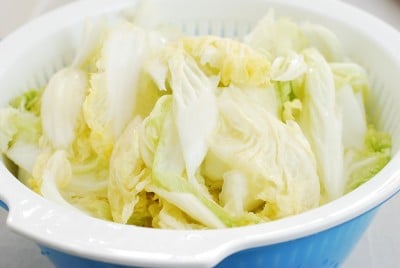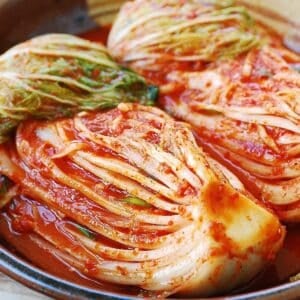Geotjeori is basically a kimchi that’s made to be eaten fresh without fermentation. As such, the vegetables are lightly salted, and this kimchi is quick and easy to make.
Last month, I introduced a salad-like kimchi called geotjeori (겉절이) using baby bok choy. Geotjeori is basically a kimchi that’s made to be eaten fresh without fermentation. As such, the vegetables are lightly salted.
Fresh kimchi goes especially well with dishes such as kalguksu (warm noodle soup) and Korean BBQ meat. Geotjeori is most commonly made with napa cabbage, baechu (배추).
Summer napa cabbages tend to be small with thinner leaves, and it’s perfect for making baechu geotjeori. If you have a large cabbage, only use the inner tender parts. You can save tough outer leaves for baechu doenjang guk later.
Because it’s eaten without fermentation, during which a natural sweetness develops, the addition of sugar or corn syrup (or Korean rice syrup) helps round out the flavor of geotjeori.
In this recipe, I also used Korean plum syrup called maesil chung (매실청). You can simply omit it if you don’t have it, but it adds a natural fruity sweetness to the dish. Maesil chung is not an ingredient that I grew up with, but it has recently become a popular ingredient.
I also added minari (water dropwort) and buchu (garlic chives) to this recipe for extra flavors. They are in season and available in Korean markets in my area. You can omit them if you can’t find them.
Watch how to make it
Please watch the video and subscribe. Thank you!
For more Korean cooking inspirations, follow along on YouTube, Pinterest, Twitter, Facebook, and Instagram.

Baechu Geotjeori (Fresh Kimchi)
Print RecipeIngredients
- 1 small about 2.5 pounds baechu, (napa cabbage)
- 3 tablespoons coarse sea salt less if using finer salt
- 2 scallions
- 2 ounces buchu garlic chives, cut into 2-inch pieces - optional
- a few stalks minari water dropwort, cut into 2-inch pieces - optional
Seasoning
- 4 tablespoons gochugaru Korean red chili pepper flakes
- 3 tablespoons myulchi aekjeot 멸치액젓 (fish sauce)
- 1 tablespoon corn syrup or Korean rice syrup
- 1 tablespoon maesil cheong 매실청 (Korean plum syrup) - or a bit more corn syrup
- 1 tablespoon minced garlic
- 1 teaspoon finely grated ginger
- 1 teaspoon sesame seeds






























AF says
What’s the difference between this and your easy kimchi recipe? I see syrup being added to this but not much else. Thanks!
Shiereen says
I have been craving this ever since I had this in a Korean restaurant in Rotterdam 3 years ago. Looked up several recipes but this is the one! Absolutely delicious. Thank you so much. This will become a regular in my household. I also love your website and the way you guide through recipes.
Schuz says
How long can we keep this in fridge after making?
Hyosun says
It should keep well for a week or longer, but it will become slightly watery over time as this is very lightly salted for consumption without fermentation. This type of kimchi tastes best within 2 to 3 days.
Hearts says
I just made the Fresh Kimchi & its delicious! Thank you! I’ve been making a lot of your recipes & they are all fantastic.
Just a suggestion, if you can post links to the brands that you buy it would be very helpful. Or pics of the bottles. As a non-Korean reader, once at Hmart all the bottles are written in Korean with a few products with English its very confusing. Plus suggestions to which are your favorite brands would be wonderful as I have no clue which brands are preferred.
Thank you for all your lovely recipes!
Amy says
I am allergic to seafood. Can I leave out the fish sauce? Or is there a substitute I can use instead? Thank you. Love your blog and your recipes!
Hyosun says
Yes you can leave it out but have to use more salt. Korean soup soy sauce (not regular soy sauce) is a good substitute if you have it.
Andrew Leung says
i don’t normally post comments, but i had to for this one. the kimchi was delicious and fresh, and i won’t ever get store-bought ones again. the maesil chung really made a difference and i would recommend for anyone trying this recipe to get it. thanks!
Jamyang Choden says
Is it okay to use Gochujang sauce if I do not have gochugaru?
Hyosun says
You can try it, but it’ll be quite different and not how this dish is usually made. Also, please know gochujang is salty and slightly sweet, so you’ll need to adjust the other ingredients.
Adriana says
Can’t wait to try it!
I’m going to the Asian shop to buy all the missing ingredients tomorrow and I was wondering is it possible to ferment this mixture for fermented kimchi or should I use a complete different tecnique?
I’m sorry if this is a stupid question but I’m a complete newbie in Korean kitchen!
Hyosun says
This recipe is lightly salted and seasoned for immediate consumption. If you want to make kimchi for fermentation, use my easy kimchi recipe. You can halve the recipe if you want to make less from the following recipe:
https://www.koreanbapsang.com/mak-kimchi-simple-kimchi/
Lita says
How long will this keep in the fridge?
Hyosun says
It will taste the best for the first few days, but can last for a couple of weeks.
Amy says
I made this today. Such a nice refreshing snack to eat during a heat wave. Highly reccomend and I will definitely make again to share with friends. Thank you!
Scott says
I love kimchi and have been wanting to make both fresh and fermented versions. This was my first attempt at making fresh kimchi and it was incredible. I didn’t have the optional veggies and sweeteners, so I used more green onion and small cucumbers (love the fresh cucumber kimchi from H-mart) and a little kimchi sauce. It was easy to make and got better each day. I’m making a new batch tonight… Thanks!
Nora Nero says
안녕하세요, 효선 어머니 (I’m sorry if I don’t spell your name correctly). I’m one of your recipe follower from Indonesia
About a week ago, I made geotjeori with recipe from local website in my country. I used sugar as instructed, but then found out that the sugar didn’t solve properly with the other ingredients (I still could bite the crystal and feel the sandy-taste on my tongue)
Then I just found here in your website to use corn syrup as the sweetener. My question is: can I substitute the corn syrup with honey? Because I often read about that substitution in another Korean cooking website
너무 많이 감사합니다
Billie says
I loved this recipe. I didn’t have plum syrup and didn’t want to use corn syrup so I just used honey and it turned out fine. We ate some fresh, but then placed the rest in a glass jar and let it sit at room temp for a day then placed in the fridge. There was slight fermentation afterwards but it was perfect and my husband and teen daughter loved it. It also was not too salty at all.
Nora Nero says
안녕하세요, 효선 어머니 (I’m sorry if I don’t spell your name correctly). I’m one of your recipe follower from Indonesia
About a week ago, I made geotjeori with recipe from local website in my country. I used sugar as instructed, but then found out that the sugar didn’t solve properly with the other ingredients (I still could bite the crystal and feel the sandy-taste on my tongue)
Then I just found here in your website to use corn syrup as the sweetener. My question is: can I substitute the corn syrup with honey? Because I often read about that substitution in another Korean cooking website
너무 많이 감사합니다 🙏🙏
Tara Story says
I cannot find napa cabbage in my area. Can I use western cabbage for this recipe? If so, what changes should I make to the recipe?
Thank you!
Hyosun says
Of course you can! Here’s the recipe:
https://www.koreanbapsang.com/yangbaechu-kimchi-green-cabbage-kimchi/
Kuulei says
My 8 year old granddaughter loves this geotjori kimchi recipe! Thank you for posting this!
Hyosun says
Awesome! Happy to hear that!
Judy Rivas says
I love fresh kimchi! Thank you for the recipe. Does this go bad after a long time? How long do u recommend eating it and what can you use the leftover fresh kimchi for?
Shellie says
Is it possible to add some extra salt and let this particular recipe ferment on the counter for a day? Or should I just use a different recipe for that? Thanks! Love your recipes!
Tommy Ikeda says
Awesome recipe. I cheat with a little MSG. Thank you.
Veronica says
Thank you so much for this recipe. Do you have any suggestion for what to so with this kimchi after 2 weeks? Can I make kimchi pancake of stew with this kimchi? Or fried rice?
Faleea Nanda says
Hello Ms. Hyosun, I really love your fresh kimchi recipe. I’ve made this and yes, this is soooo good! So crunchy and fresh and a little bit hot. What I want to ask you is where and how can I keep the left gochugaru? I bought the pack for 500 gr/pack and I just use it for this recipe and now I got confused how to keep it.
Thank you so much
Hyosun says
So happy to hear it turned out soooo good for you! I keep my gochugaru in the freezer. It will keep for a long time. Cheers!
Linda says
Hello, i love your recipes!
Can i mix this mak kimchi recipe with fresh oyster? There is my favorite korean restaurant that sells very nice galbi tang in california, and it was served with oyster kimchi (taste slightly sweet, not sour). I really like to know how to make it. Thanks.
Hyosun says
Yes you can. In fact, that’s what I do sometimes. Enjoy!
Jo says
hello, i need to know if i can add toasted sesame seeds when serving only? i totally forgot abt it. And i did not take note that these should be made in small batches…i got too excited abt it HAHAHA! and i read i can keep it for weeks?? will it turn sour? i made it becos my family prefers kimchi tat is not sour..
Hyosun says
Yes, that’s fine. Sorry for the late reply. I hope you enjoyed it.
Kathryn says
Hi, thanks for posting this recipe! I have been looking it for a long time after trying it at a restaurant few years ago. We also live near D.C. Do you buy the korean plum syrup? If so can you recommend a store such as one of the big chains in this area we can find it?
Thanks!
Hyosun says
Hi Kathryn – You should be able to find them at most Korean markets in the area, such as Lotte, Grand Mart, and H-Mart. Thanks!
Little Cooking Tips says
Excellent recipe Hyosun! We don’t have plum syrup, but we have a delicious natural grape syrup here in Greece, called petimezi. We can’t wait to try your recipe in our next Asian-marinated turkey BBQ!:)
Loved it!
Panos and Mirella
Hyosun says
Grape syrup sounds really good! I am sure it will work beautifully with this recipe! Thank you so much for all your support and love for my blog!
Kathryn says
Hello! This recipe looks great, and I love your blog. I’ve found so many recipes here that I can’t wait to make!
Hyosun says
Hello Kathryn! Thank you for the love! Hope you enjoy many of my recipes.
SM says
Hi Hyosun, how long can this kimchi keep?
Hyosun says
It will keep for a couple of weeks. If you want to keep it longer, make it a little saltier.
SM says
Thanks! Will try this out.